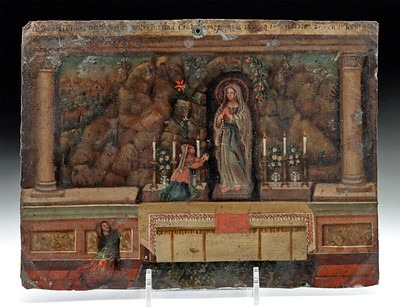Egyptian Faience Thoth Amulet + Bronze Sun Disk
Lot 14
About Seller
Artemis Fine Arts
686 S Taylor Ave, Ste 106
Louisville, CO 80027
United States
Selling antiquities, ancient and ethnographic art online since 1993, Artemis Gallery specializes in Classical Antiquities (Egyptian, Greek, Roman, Near Eastern), Asian, Pre-Columbian, African / Tribal / Oceanographic art. Our extensive inventory includes pottery, stone, metal, wood, glass and textil...Read more
Estimate:
$450 - $675
Absentee vs Live bid
Two ways to bid:
- Leave a max absentee bid and the platform will bid on your behalf up to your maximum bid during the live auction.
- Bid live during the auction and your bids will be submitted real-time to the auctioneer.
Bid Increments
| Price | Bid Increment |
|---|---|
| $0 | $25 |
| $300 | $50 |
| $1,000 | $100 |
| $2,000 | $250 |
| $5,000 | $500 |
| $10,000 | $1,000 |
| $20,000 | $2,500 |
| $50,000 | $5,000 |
| $100,000 | $10,000 |
| $200,000 | $20,000 |
About Auction
By Artemis Fine Arts
Jun 15, 2023
Set Reminder
2023-06-15 10:00:00
2023-06-15 10:00:00
America/New_York
Bidsquare
Bidsquare : VARIETY Ancient, Ethno, Native American, Fine Art
https://www.bidsquare.com/auctions/artemis-gallery/variety-ancient-ethno-native-american-fine-art-12990
Antiquities, ethnographic, native american and fine art from cultures encompassing the globe. Artemis Fine Arts info@artemisgallery.com
Antiquities, ethnographic, native american and fine art from cultures encompassing the globe. Artemis Fine Arts info@artemisgallery.com
- Lot Description
Egypt, Late Dynastic Period, 26th to 31st Dynasty, ca. 664 to 332 BCE. A lovely pair of artifacts from Ancient Egypt: a faience amulet of the god Thoth and a bronze sun disk. Enveloped in turquoise glaze, the ibis-headed deity is shown in stride, wearing a pleated skirt with arms at sides. Conversely, the bronze sun disk is flanked by a pair of cow horns meant to represent the goddess Hathor. Size of larger (Thoth pendant): 0.5" W x 2" H (1.3 cm x 5.1 cm)
Please note this was part of the Leavitt Hunt collection. Hunt (1831 to 1907) was a lawyer, world traveler, and photographer and the first American, if not the first person, to make a photographic record of the Near East and Mediterranean, during his "Grand Tour" from 1851 to 1852, alongside his friend, Nathan Flint Baker (1820-1891). Hunt and Baker captured calotype images of some of the greatest ancient ruins of the Classical World, and these prints are invaluable early artistic photographs as well as historical records of the sites, and several were donated by Hunt's family to the Library of Congress as part of the permanent collection, as well as other institutions. Besides taking photos, artifacts were personally collected by Hunt in the various countries he visited, including this piece.
Provenance: ex-Natalie Capron, Vermont, USA, 1972 to 2008, now by her heirs; ex-Maurice Crandall, Vermont, 1941 to 1972; ex-Clyde du Vernet Hunt, Vermont, 1916 to 1941; ex-Katherine Jarvis Hunt, Vermont, 1907 to 1916; ex-Leavitt Hunt, Vermont, collected 1851 to 1852
All items legal to buy/sell under U.S. Statute covering cultural patrimony Code 2600, CHAPTER 14, and are guaranteed to be as described or your money back.
A Certificate of Authenticity will accompany all winning bids.
We ship worldwide and handle all shipping in-house for your convenience.
#174390Losses to Thoth's feet and plinth. Both have expected surface wear with nick, abrasions, and softening of detail, commensurate with age. Great remaining glaze on faience and rich patina throughout both.Condition
- Shipping Info
-
All shipping is handled in-house for your convenience. Your invoice from Artemis Gallery will include shipping calculation instructions. If in doubt, please inquire BEFORE bidding for estimated shipping costs for individual items.
-
- Buyer's Premium



 EUR
EUR CAD
CAD AUD
AUD GBP
GBP MXN
MXN HKD
HKD CNY
CNY MYR
MYR SEK
SEK SGD
SGD CHF
CHF THB
THB













